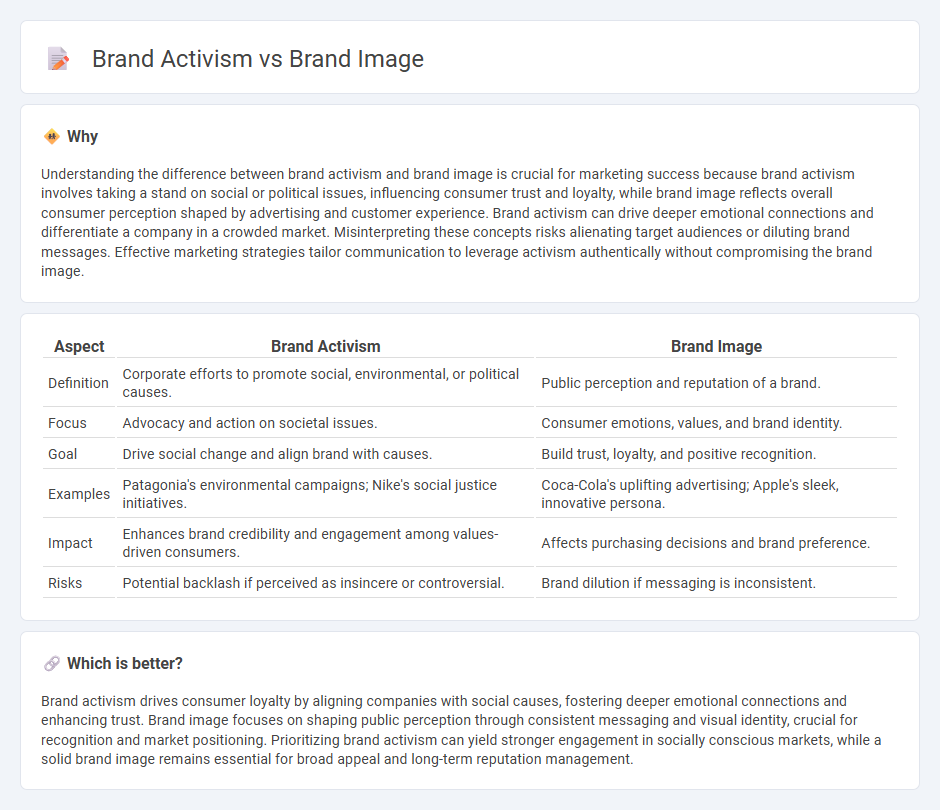
Brand activism involves companies taking a stand on social, political, or environmental issues to align with their audience's values, whereas brand image reflects the public perception shaped by marketing efforts and customer experiences. While brand image focuses on reputation management and consistent messaging, brand activism actively engages in advocacy and social responsibility that can influence consumer loyalty and trust. Explore how integrating brand activism can redefine your brand image and drive meaningful connections.
Why it is important
Understanding the difference between brand activism and brand image is crucial for marketing success because brand activism involves taking a stand on social or political issues, influencing consumer trust and loyalty, while brand image reflects overall consumer perception shaped by advertising and customer experience. Brand activism can drive deeper emotional connections and differentiate a company in a crowded market. Misinterpreting these concepts risks alienating target audiences or diluting brand messages. Effective marketing strategies tailor communication to leverage activism authentically without compromising the brand image.
Comparison Table
| Aspect | Brand Activism | Brand Image |
|---|---|---|
| Definition | Corporate efforts to promote social, environmental, or political causes. | Public perception and reputation of a brand. |
| Focus | Advocacy and action on societal issues. | Consumer emotions, values, and brand identity. |
| Goal | Drive social change and align brand with causes. | Build trust, loyalty, and positive recognition. |
| Examples | Patagonia's environmental campaigns; Nike's social justice initiatives. | Coca-Cola's uplifting advertising; Apple's sleek, innovative persona. |
| Impact | Enhances brand credibility and engagement among values-driven consumers. | Affects purchasing decisions and brand preference. |
| Risks | Potential backlash if perceived as insincere or controversial. | Brand dilution if messaging is inconsistent. |
Which is better?
Brand activism drives consumer loyalty by aligning companies with social causes, fostering deeper emotional connections and enhancing trust. Brand image focuses on shaping public perception through consistent messaging and visual identity, crucial for recognition and market positioning. Prioritizing brand activism can yield stronger engagement in socially conscious markets, while a solid brand image remains essential for broad appeal and long-term reputation management.
Connection
Brand activism directly influences brand image by demonstrating a company's commitment to social and environmental causes, which enhances consumer trust and loyalty. Consumers increasingly expect brands to take a stand on relevant issues, making activism a strategic tool to differentiate and strengthen brand identity. Positive brand activism campaigns can significantly improve public perception and drive long-term engagement.
Key Terms
**Brand Image:**
Brand image encompasses the perceptions and associations consumers hold about a company, shaped by its visual identity, messaging, and customer experiences. It plays a critical role in influencing brand loyalty, trust, and market positioning by reflecting consistent values and quality. Explore how cultivating a strong brand image can drive business success and customer engagement.
Perception
Brand image centers on the overall consumer perception and reputation of a company, shaped by marketing, customer experience, and product quality. Brand activism involves a company actively supporting social, political, or environmental causes to influence public opinion and demonstrate corporate values. Explore how aligning brand activism with your brand image can enhance consumer trust and loyalty.
Identity
Brand image represents the perception consumers hold about a company's identity, shaped by logos, messaging, and customer experiences. Brand activism reflects a company's commitment to social, environmental, or political causes that align with its core values and authenticity, influencing public trust and loyalty. Explore how balancing brand image and activism can strengthen your brand identity and consumer connection.
Source and External Links
What Is Brand Image? - Importance & Examples - Brand image is the customer's perception of a brand, formed from interactions and experiences that shape their beliefs and impressions about the brand.
What is brand image? A definition. - Brand image is the general impression and associations a customer has about a brand, influenced by experiences and the brand's identity.
What Is Brand Image and How Do You Measure it - Brand image refers to the customer's perception of a brand based on interactions, which can evolve over time and does not necessarily involve purchasing or using the brand's products.
 dowidth.com
dowidth.com